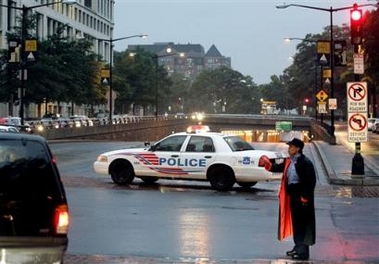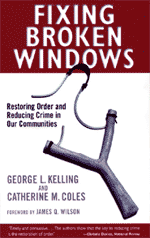Reprint of Crime Time (July 2006 blog entry)

AP photo by Evan Vucci.
[The July 18th, 2006 issue of] the Washington Post has three pieces on the front page of the (DC edition) Metro section about DC's crime emergency. One, "Mayor Unveils Emergency Legislation," is about proposals to hire more police officers, fund more officers to work overtime, and legalizing surveillance cameras (given the city's history in violation of civil rights for demonstrators, I have some concern about this).
Another is by the columnist Marc Fisher, "D.C.'s Reaction to Killings Misses the Point," and he writes:
Never mind that crime has been dropping for years, and homicides are actually slightly down from this time last year. No, the city must take action. So Police Chief Charles Ramsey declares a crime emergency.
And in parts of the city where people swallow hard every time they step out of their houses, where every day feels like an emergency, resentment bubbles anew. Across Washington, we fall into another round of competitive suffering, an ugly sport that pits rich against poor and white against black.
Finally, the article "Police Had Suspects' Address," discusses something just as serious, that apparently a previous robbery victim had reported information to the police about the location of the suspects eventually arrested for the subsequent murder:
The information came from a 24-year-old Georgetown woman who was held up June 11 -- three blocks from the place where Senitt later would be slain. She said she provided the address on Robinson Place SE after learning that her credit card was used to make a purchase that was shipped there. ...
Police responded by telling her they could not get an arrest warrant without first doing surveillance at the apartment building and then conducting a lineup to determine whether she could identify suspects. She said she was sure she could identify her attackers and was waiting for a call from the police.
Instead, she said, on July 9 she saw the faces of the men who robbed her flash across a television screen because they had been arrested in Senitt's slaying.
Perhaps one of the biggest problems in dealing with crime in the city comes from a lack of sense of urgency on the part of investigators.
But the article also includes a quote from one of the leaders of the police officers' union, which shows that the average police officer appears to know little about the etiology of crime, especially murder. From the article:
The police work on the Senitt case also is drawing criticism of another sort from the union representing the department's officers. A document obtained by The Post shows that officers from each of the department's seven districts were called to respond to Georgetown the night of the slaying to set up a 20-block perimeter in hopes of catching the suspects.
That is highly unusual and rarely, if ever, happens when homicides occur in other, less affluent districts, said Officer Kristopher Baumann, chairman of the D.C. police labor committee for the Fraternal Order of Police Lodge 1.
Most murders in the city are crimes of anger and rage and occur between people who know each other. This number is as high as 70-80%. Police can have very limited impact on these types of murders--other than catching people for other crimes, convicting them, and putting them in jail, therefore reducing their ability to commit subsequent crimes, including murder.
The kind of murder that happened in Georgetown is of the type that can be immediately impacted by policing. If Officer Baumann doesn't understand this, he needs either more training or retraining.
You know how it used to be in vogue that cities had campaigns where everyone was supposed to read the same book and have a community conversation about it? Well, if I were mayor, one of the first books I would have people read would be Cities: Back from the Edge, which is one of the best books about bottom-up urban revitalization.
Maybe the second book, and clearly the Metropolitan Police Department needs to have a similar campaign, where every member of the department reads this book and discusses it, is Fixing Broken Windows.
There is a lot of controversy and misinformation about the policing strategy outlined and called for in this book. There are two basic points:
1. How the environment looks communicates to people about what is acceptable and unacceptable behavior. Disorder increases in unkempt areas.
2. The kind of criminals that commit big crimes also commit "small" crimes. So if you don't ignore small crimes, you can have significant impact on the crime rate, because catching people for "small" crimes ends up yielding people who also commit big crimes.
But it's not just the physical order, but the social and cultural order of the community that must be addressed.
A brief in The Atlantic Monthly, where the strategy was first developed in a few articles over a 15 year period, they write in the January 1997 issue:
"We used the image of broken windows to explain how neighobrhoods might decay into disorder and even crime if no one attends faithfully to their maintenance." 'Broken Windows' was a congent argument for emphasizing 'order maintenance' to prevent crime; the ideas it contained became the template first for the NYC Transit Authority's efforts to restore order to the subway and then for the NYC Police Department's new community policing strategy.
The Transit Authority achieved success only after a frustrating ordeal of persuasion and step-by-step implementation [which is described in the book]. The transit police were skeptical. "Where in the hell did you ever get the crazy idea that disorder was police business?" one patrol officer shouted at Kelling, "Our job is fighting crime."
Fighting crime is a lot of things, and the political culture in DC hasn't been supportive of looking at the real issues, some of which Marc Fisher touches upon in his column. Instead, most elected officials are quick to criticize Chief Ramsey, who does have some failings (especially on civil liberties) but who is working diligently to change the race-charged atmosphere of the police department, and get it focused on addressing the fundamental need for change within the department and within the city in which it works.
Or Ward Six City Council Candidate Leo Pinson, who calls for "regime change" in the department, according to this recounting of a recent candidates forum in the Common Denominator, "Council candidate says 'regime change' needed to fix MPD". Pinson, who was a PSA Citizen Coordinator, and is an MPD Volunteer Reserve Officer, reflects the sentiment of the officers, and it appears to lack the grounding in criminology that I would like to see in a City Councilmember.
Most officers grouse that the department makes it very difficult to be effective on the street, that they lean overboard towards perpetrators--e.g., it is easy for someone to file a complaint against an officer for the over use of force, and this leads to many officers becoming quite cautious. But the top echelon of the department merely responds to the political climate in the city. I guarantee you that Chief Ramsey wants criminals in jail...
Pinson is right that a regime change needs to occur, but in two respects the change that is required goes far beyond the department, to: (1) many of the elected officials and (2) within segments of the community that see police as the enemy rather than people working to make our city livable and safe.

---------------------- [added -- at the time of the original entry, the Broken Windows wasn't freely accessible online]
Also see the article "Broken Windows" from the Atlantic Monthly.
This article is from 1982!!!!!!!!!! After 27 years, you'd think it would be possible to have adopted such a focus within many police departments and communities, rather than it still being considered a novel technique!
Labels: civic engagement, crime, organizational development, planned change, planning, public safety, public space management



0 Comments:
Post a Comment
<< Home